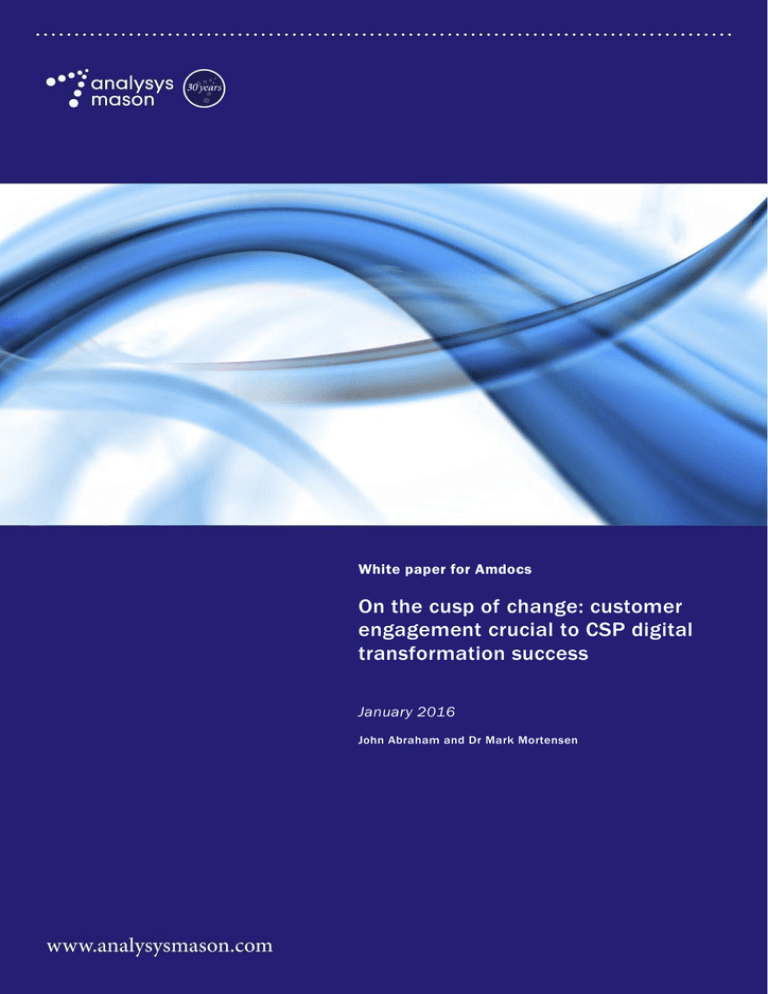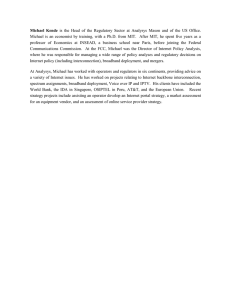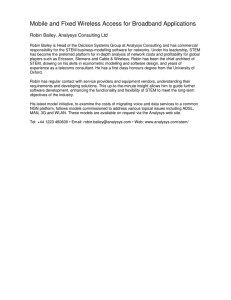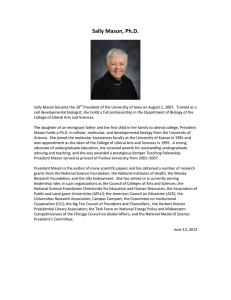
White paper for Amdocs
On the cusp of change: customer
engagement crucial to CSP digital
transformation success
January 2016
John Abraham and Dr Mark Mortensen
.
Customer engagement crucial to CSP digital transformation success | i
Contents
1.
Executive summary
1
2.
Introduction
1
3.
Mapping the customer journey
2
4.
Crossing the chasm in customer engagement
3
5.
Conclusion: on the cusp of change
5
6.
The Amdocs Digital Experience approach
6
About the authors
7
About Analysys Mason
8
© Analysys Mason Limited 2016
Contents
Customer engagement crucial to CSP digital transformation success | 1
1. Executive summary
The Internet era has triggered a massive shift in the telecoms industry resulting in strong competition, declining
voice revenues and dramatic growth of data consumption. Communications service providers (CSPs) worldwide
are actively exploring ways to defend against the competitive threats of digital economy players, while
capitalising on their strengths and network infrastructure to become a more integrated part of the digital
economy and the associated growth opportunity.
Meanwhile the Internet era has also triggered significant change in customer behaviour and expectations.
Customers have become accustomed to seamless user experience and real-time control of their services and
expect nothing less from their service providers. CSPs are pressured to improve their user experience while also
navigating the complexities of interlinking their legacy platforms to provide a consistent interface. Establishing
an effective customer engagement model in the midst of the evolving digital economy landscape is critical for
CSPs to ensure they are not bypassed in the value chain.
This thought leadership white paper focuses on the significance of exceptional customer engagement and
provides a brief overview of how CSPs could innovate on customer engagement and experience.
2. Introduction
The advent of the Internet era has had a unique and profound impact on businesses worldwide. Businesses that
provide online digital services, digital substitutes for traditional goods and services, or physical goods marketed
and sold by digital means are compelled to participate in the digital economy or risk significant disruption.
The move to the digital economy has also had a significant impact on communications service providers (CSPs).
IP-based over-the-top (OTT) service providers of all sizes – from Internet giants to small, agile start-ups – have
disrupted CSPs’ traditional voice and messaging revenues. CSPs have retained some inherent advantages such
as existing customer relationships and network infrastructure that give them invaluable leverage to become an
indispensable part of the digital economy world order. In order to do this, however, CSPs need to undergo a
digital transformation and make significant changes to how they engage with their customers.
The rise of Internet giants such as Amazon and Google has caused notable changes to customer behaviour and
expectations. Customers expect real-time, personalised, customisable experiences for both digital and nondigitised services. For instance, consider recent digital economy companies such as Airbnb, Instacart and Uber
who have tasted huge success. Airbnb offers rooms, Instacart delivers groceries and Uber hails taxis. None of
these services are digitised – what sets these companies apart is their exceptional customer engagement model.
In short, by implementing a great customer interface between the services and the customer, these companies
have significantly disrupted their industry.
As CSPs engage in actively defending against the competitive threats of digital economy players, they would do
well to give heed to the most common disruption model: providing an exceptional customer experience that
brings together disparate complex services.
© Analysys Mason Limited 2016
Introduction
Customer engagement crucial to CSP digital transformation success | 2
3. Mapping the customer journey
The first step towards creating an exceptional customer experience is to map the customer journey. This is
especially true for CSPs, who typically provide a number of services, including complex bundles. The
significant rise in the number and types of available services creates both opportunities and challenges for CSPs
worldwide.
CSPs are at the threshold of offering a large variety of new digital economy services such as home networking
and security, cloud-based software subscription services, machine-to-machine communications, and many more.
Under these circumstances, the need to predict and be prepared for the customer interaction journey could not be
more relevant.
Consumers want control over their customer journey, choosing their own paths with complete flexibility. There
is a need to provide multiple journey paths that customers can take as they become aware of an offering from a
CSP, research the offering, choose an offering, and (hopefully) become public advocates of the offering. Today,
most CSPs’ primary channels are websites and customer care agents while some also provide smartphone and
tablet apps, and kiosks and retail stores. Other channels such as Facebook, Twitter and other social media tools
are also becoming important.
The platforms of the future will allow customers to choose how they interact with CSPs while guiding the
customer journey subtly to ensure appropriate engagement and desired outcomes for CSPs. Broadly speaking, a
typical customer journey can have infinite outcomes or limited guided outcomes.
Infinite outcomes: The infinite outcomes customer journey approach provides an infinitely flexible set of
paths for customers to follow as they interact with the CSPs, their agents and their partners through omnichannel architecture. Designing an infinite number of potential customer journeys is complex, and effective
customer engagement within this model can be time-consuming and expensive.
Guided outcomes: The guided outcomes approach presents customers with a limited number of potential
customer journeys, although customers still retain control over the path they want to take from the options
available. Customers are guided to an ideal outcome by providing information on the offer that best suits
them. This approach is designed around the paradigm of ‘the greatest need to the greatest number’ as
opposed to the infinite outcomes approach of ‘all things to all people’. Guided outcomes offer CSPs more
effective control over customer engagement. By limiting the number of customer journeys, CSPs can focus
on providing compelling customer experiences.
© Analysys Mason Limited 2016
Mapping the customer journey
Customer engagement crucial to CSP digital transformation success | 3
Figure 1: Comparing infinite customer outcomes and guided customer outcomes approaches [Source: Analysys
Mason, 2016]
4. Crossing the chasm in customer engagement
Frictionless transactions underpin effective customer engagement, which itself requires in-depth understanding
of the customer journey. For instance, consider Uber. Valued at over USD50 billion today, it is the most
valuable private technology company in the world. That is staggering for a company which started operations
just five years ago, in 2010. How did Uber become so successful so quickly on the back of an industry that has
been around for decades? It created an exceptional customer experience by first understanding the pain points of
the typical customer journey. The new thing about Uber is not the taxi ride itself, but rather the customer
engagement model. Today customers can hail a taxi on their smartphones and watch the progress of the taxi on a
map in real time. The billing process is seamless, and users do not have to fumble through their wallets for the
right change. By innovating on customer engagement and experience, Uber has upended the taxi industry.
© Analysys Mason Limited 2016
Crossing the chasm in customer engagement
Customer engagement crucial to CSP digital transformation success | 4
Figure 2: Characteristics of an ideal customer engagement model [Source: Analysys Mason, 2016]
A clean interface is one which is designed around necessities. Stripping away the inessentials
reduces complexity and helps create a simpler, engaging environment for customers.
The contextual system provides tailored services to the customer which is applicable for the
moment. It leverages analytical models and real-time data to provide relevant information,
which improves engagement and helps build conversations.
The convenient user-engagement model is built around accessibility and speed of service
and allows customers greater control over their interactions. The interactions are seamless
and offer customers useful choices.
A consistent interface provides a uniform customer experience across services without major
deviations or disruptions. Habitually consistent experience builds customer trust and loyalty.
While Uber customers are treated to a seamless experience, the scene below the surface is far from simple.
There are a myriad of challenges around regulation, predicting demand and managing supply, and traffic
management and location tracking, among others. The end user is blissfully unaware of these underlying
complexities and is presented with an interface that is clean, contextual, convenient and consistent.
This deep underlying complexity that Uber tactfully navigates is, in many ways, representative of the challenges
that CSPs also encounter. The big challenge that CSPs face is to cross the chasm of experiential engagement
with customers by offering an easy-to-use interface. Most large CSPs have multiple interaction channels, many
of which are silos and inconsistent in their messaging. Consumers today demand consistent real-time control
over their services, comparable to online services from Internet firms. Accomplishing this through a traditional
transformational approach can be an expensive and risky proposition. However, CSPs focused on improving
their customer engagement can deploy a customer experience unifying platform that can help provide a more
engaging customer interaction experience. Figure 3 presents a snapshot of how CSPs can leverage a unifying
customer experience platform to improve customer engagement.
While Figure 3 presents a simplified view of how a customer-experience-unifying platform will function, the
actual design and deployment is intricate and will require deep domain expertise to overcome a myriad of
system complexities. The particulars around the deployment of such platforms are beyond the scope of this
white paper and CSPs are best advised to engage with vendors and experts who have deep domain knowledge
across business support systems (BSS).
© Analysys Mason Limited 2016
Crossing the chasm in customer engagement
Customer engagement crucial to CSP digital transformation success | 5
Figure 3: Layered view of CSP-powered exceptional customer engagement [Source: Analysys Mason, 2016]
5. Conclusion: on the cusp of change
The Internet era has triggered a massive shift in the telecoms industry with strong competition, declining voice
revenues and dramatic growth of data consumption. CSPs worldwide are actively exploring ways to defend
against the competitive threats of digital economy players, while capitalising on their strengths and network
infrastructure to become a more integrated part of the digital economy and the associated growth opportunity.
Establishing an effective customer engagement model in the midst of the evolving digital economy landscape is
critical for CSPs to ensure they are not bypassed in the value chain. While CSPs have all the ingredients to
become much more than a dumb pipe in the digital economy value chain, they need to ensure customer
engagement is relevant, consistent and exceeds expectations. Customer behaviour and expectations are shifting,
driven by customer interactions with new-age online digital companies and CSPs would do well to invest in
back-end support systems in order to provide a comparable customer experience.
© Analysys Mason Limited 2016
Conclusion: on the cusp of change
Customer engagement crucial to CSP digital transformation success | 6
6. The Amdocs Digital Experience approach
Amdocs’ vision for digital telco is built around providing a complete set of capabilities for CSPs to effectively
engage with customers, employees and partners across all channels and touch points. Amdocs Digital
Experience extends coverage from core BSS capabilities into enabling a consistent and personalized experience
across assisted and unassisted channels. It is comprised of solutions which deliver a comprehensive omnichannel engagement that supports consistent data, channel hopping and process continuity. The six key building
blocks of the Amdocs Digital Experience are:
Figure 4: Key considerations for delivering a digital experience [Source: Amdocs, 2016]
Omni-channel: Amdocs omni-channel strategy is built around ensuring the same information is
available on both assisted and unassisted channels through the use of widgets so that CSPs can build
once and deploy across multiple channels.
Personalization: Amdocs Digital Experience uses insights based on the customer profile and online
behaviour and navigation, utilizing data such as eligibility, compatibility and service usage patterns to
enable contextual promotions. It also delivers dynamic pricing for products and services during
configuration, and is integrated to Amdocs Big Data analytics for targeting and micro segmentation.
Commerce: Amdocs Commerce solution delivers a single catalogue driven shopping experience for all
business services from traditional services to multi-play, entertainment and digital content. The
capabilities range from supporting end-to-end purchase journeys for new customers to assisting
existing customers while they explore new plans or upgrades, personalized pricing, comparison of
items, order tracking and search engine optimization. These flows are supported and integrated across
digital interfaces, contact centres and retail channels.
Self-service: Amdocs Digital Care solution powers both assisted and unassisted channels with a
specific focus on self-service capabilities that enable customers to manage and track their account
effectively. It also enables CSPs to cross-sell and up-sell services by providing end-to-end visibility
and insight into the customer journey across various touchpoints.
Business agility: Amdocs Digital Experience is built on a single master enterprise catalogue which
integrates across all channels allowing for faster time to market for new products and services.
Business users are also empowered to create their own experience with an abstraction of widgets into
the web content management platform.
Innovation: Amdocs assists CSPs to improve customer engagement and experience by connecting to
an ever-growing partner ecosystem tailored to provide channel specific solutions.
The Amdocs Digital Experience combined with a complete set of products and services from strategy and
design to implementation and managed services supports CSPs in their transition to a digitally enabled service
provider. Amdocs leverages its deep understanding of intricate CSP environments by removing complexity in
order to enable a superior digital customer experience.
© Analysys Mason Limited 2016
The Amdocs Digital Experience approach
Customer engagement crucial to CSP digital transformation success | 7
About the authors
John Abraham (Senior Analyst) is part of the BSS practice in Analysys Mason’s Telecoms
Software Research team. He leads our Revenue Management programme and contributes to
mobile money research for the Digital Economy Software Strategies programme. John has
been part of the telecoms industry since 2006, and joined Analysys Mason in early 2012. He
has worked on a range of telecoms operator projects in Africa, Europe, India and the Middle
East. Before joining Analysys Mason, he worked for Subex, a provider of BSS offerings. John
holds a bachelor’s degree in computer science from Anna University (India) and an MBA from Bradford
University School of Management (UK).
Dr Mark H. Mortensen (Practice Head) leads the BSS practice and is personally the lead
analyst for Analysys Mason’s Customer Care, Service Fulfilment and Digital Economy
Software Strategies research programmes, which are part of the Telecoms Software research
stream. His interest areas include customer self-service, new telecoms businesses entering the
digital economy value chain, and network planning and optimisation. The first 20 years of
Mark’s career were at Bell Laboratories, where he distinguished himself by starting software
products for new markets and network technologies and designing the interaction of BSSs/OSSs with the
underlying network hardware. Mark was Chief Scientist of Management Systems at Bell Labs, and has also
been president of his own OSS strategy consulting company, CMO, at the inventory specialist Granite Systems,
VP of Product Strategy at Telcordia Technologies, and SVP of Marketing at a network-planning software
vendor. Mark holds an M.Phil. and a Ph.D. in physics from Yale University and has received two AT&T
Architecture awards for innovative software solutions. He is also an adjunct professor at UMass Lowell in the
Manning School of Management, specialising in business strategy. Mark has also participated on the GSMA
Global Mobile Awards judging panel.
1
1
Published by Analysys Mason Limited • Bush House • North West Wing • Aldwych • London • WC2B 4PJ • UK
Tel: +44 (0)20 7395 9000 • Fax: +44 (0)20 7395 9001 • Email: research@analysysmason.com • www.analysysmason.com/research
Registered in England No. 5177472
© Analysys Mason Limited 2015
All rights reserved. No part of this publication may be reproduced, stored in a retrieval system or transmitted in any form or by any means – electronic,
mechanical, photocopying, recording or otherwise – without the prior written permission of the publisher.
Figures and projections contained in this report are based on publicly available information only and are produced by the Research Division of Analysys Mason
Limited independently of any client-specific work within Analysys Mason Limited. The opinions expressed are those of the stated authors only.
Analysys Mason Limited recognises that many terms appearing in this report are proprietary; all such trademarks are acknowledged and every effort has been
made to indicate them by the normal UK publishing practice of capitalisation. However, the presence of a term, in whatever form, does not affect its legal status
as a trademark.
Analysys Mason Limited maintains that all reasonable care and skill have been used in the compilation of this publication. However, Analysys Mason Limited
shall not be under any liability for loss or damage (including consequential loss) whatsoever or howsoever arising as a result of the use of this publication by the
customer, his servants, agents or any third party.
© Analysys Mason Limited 2016
About the authors
Customer engagement crucial to CSP digital transformation success | 8
About Analysys Mason
Analysys Mason is a trusted adviser on telecoms, media and technology (TMT). We work with our
clients, including CSPs, regulators and end users, to:
design winning strategies that deliver measurable results
make informed decisions based on market intelligence and analytical rigour
develop innovative propositions to gain competitive advantage.
We have more than 250 staff in 12 offices and are respected worldwide for exceptional quality of
work, independence and flexibility in responding to client needs. For 30 years, we have been helping
clients in more than 100 countries to maximise their opportunities.
Consulting
Our focus is exclusively on TMT.
We support multi-billion dollar
investments, advise clients on regulatory
matters, provide spectrum valuation and
auction support, and advise on operational
performance, business planning
and strategy.
We have developed rigorous
methodologies that deliver tangible
results for clients around the world.
For more information, please visit
www.analysysmason.com/consulting.
Research
We analyse, track and forecast the different services accessed by consumers and enterprises, as
well as the software, infrastructure and technology delivering those services.
Research clients benefit from regular and timely intelligence in addition to direct access to our
team of expert analysts.
Our dedicated Custom Research team undertakes specialised and bespoke projects for clients.
For more information, please visit www.analysysmason.com/research.
© Analysys Mason Limited 2016
About Analysys Mason





